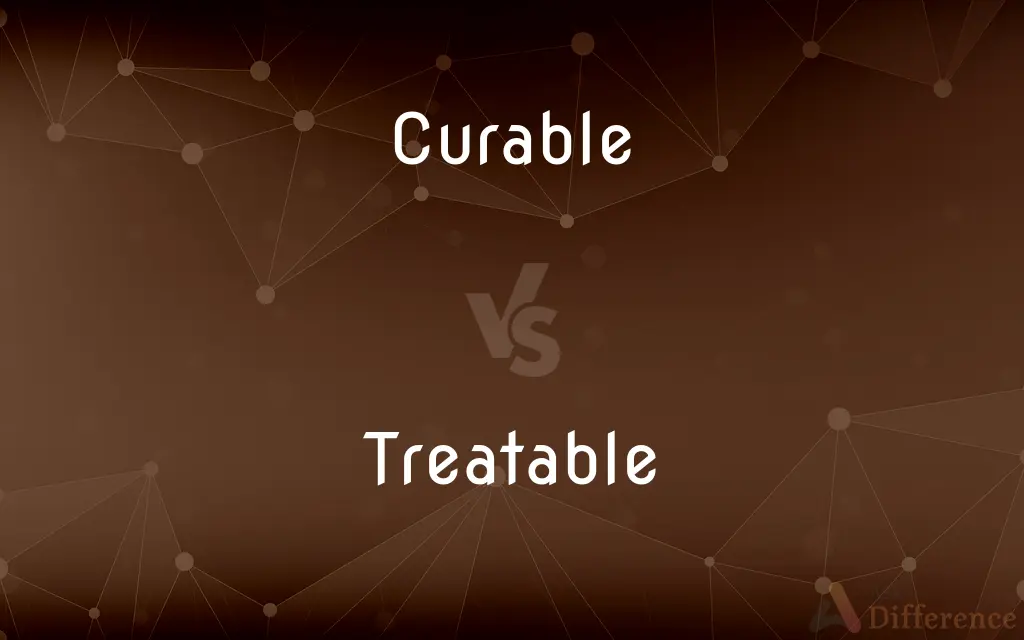Curable vs. Treatable — What's the Difference?
By Fiza Rafique & Urooj Arif — Updated on April 2, 2024
Curable diseases can be completely eradicated from the body, whereas treatable conditions can be managed or alleviated but not fully cured.

Difference Between Curable and Treatable
Table of Contents
ADVERTISEMENT
Key Differences
Curable diseases are those for which medical treatments can completely eliminate the disease, leading to a full recovery. Examples include certain bacterial infections treatable with antibiotics. On the other hand, treatable diseases are conditions for which symptoms can be managed, and progression can be slowed or halted, but the underlying disease remains, such as diabetes or chronic heart disease.
While curable conditions often have a definitive treatment course that leads to eradication of the disease, treatable conditions usually require ongoing management and lifestyle adjustments to maintain health and prevent complications.
The distinction between curable and treatable diseases highlights the importance of early detection and treatment. Early treatment of curable diseases can prevent complications and ensure a full recovery, whereas early management of treatable diseases can improve quality of life and longevity.
In the case of curable diseases, the focus is on targeting and eliminating the root cause of the illness. For treatable diseases, the approach is more about symptom management and preventing disease progression.
Understanding whether a disease is curable or treatable is crucial for setting realistic expectations for treatment outcomes. Patients with curable diseases can look forward to a life free from the disease post-treatment, while those with treatable conditions may need to adjust to living with a chronic condition.
ADVERTISEMENT
Comparison Chart
Definition
Conditions that can be completely eradicated with treatment.
Conditions that can be managed but not fully eradicated.
Treatment Goal
Complete elimination of the disease.
Management of symptoms and prevention of progression.
Examples
Bacterial infections, some types of cancer.
Diabetes, hypertension, chronic heart disease.
Outcome
Full recovery and no recurrence of the disease.
Improved quality of life, but the disease remains present.
Treatment Approach
Often involves a specific course of treatment targeting the cause.
Involves ongoing management, possibly including medication and lifestyle changes.
Compare with Definitions
Curable
A condition that can be completely removed or eliminated.
After a course of antibiotics, her strep throat was curable and she fully recovered.
Treatable
Focuses on controlling symptoms rather than curing.
Her arthritis is treatable with medication, easing discomfort and improving mobility.
Curable
The condition does not persist once treatment is completed.
His skin infection was curable with a topical ointment prescribed by his dermatologist.
Treatable
Often pertains to diseases with long-term effects.
While not curable, Type 2 diabetes is treatable with a combination of medication and lifestyle changes.
Curable
Patients can return to their pre-disease state of health.
With early detection, many types of cancer are curable, offering patients a normal life span.
Treatable
Continuous or periodic treatment is necessary to manage the condition.
His hypertension is treatable with daily medication to keep his blood pressure in check.
Curable
Treatment directly addresses and eradicates the root cause.
The curable tumor was removed surgically, leaving the patient cancer-free.
Treatable
While the disease remains, symptoms can be lessened.
Asthma is a treatable condition that, with the right management plan, allows for a normal, active lifestyle.
Curable
Once cured, no further treatment is necessary.
Once the series of vaccinations was complete, the viral infection was curable, and no additional shots were needed.
Treatable
Treatment aims to prevent the disease from worsening.
Through early intervention, many treatable conditions can be managed effectively, preventing serious complications.
Curable
Being such that curing or healing is possible
Curable diseases.
Treatable
Possible to treat; responsive to treatment
A treatable disorder.
Curable
Capable of being cured.
Treatable
Able to be treated; not incurable.
In the 1980s, AIDS was not a treatable disease, and as a consequence the mortality rate at that time was very high.
Curable
Capable of being cured; admitting remedy.
Treatable
(dated) Not intractable; moderate.
Curable
Being such that curing or healing is possible;
Curable diseases
Treatable
Manageable; tractable; hence, moderate; not violent.
A kind of treatable dissolution.
The heats or the colds of seasons are less treatable than with us.
Curable
Able to be hardened by some additive or other agent
Common Curiosities
Is diabetes curable or treatable?
Diabetes is currently treatable, not curable, with management focusing on controlling blood sugar levels.
Can treatable diseases become curable?
With advances in medical research, some diseases that are currently only treatable may become curable in the future.
Can lifestyle changes make a treatable disease curable?
While lifestyle changes can significantly manage some treatable diseases, they do not necessarily make them curable.
What does it mean if a disease is curable?
A disease is considered curable if it can be completely eradicated from the body with treatment.
What are examples of curable diseases?
Certain bacterial infections and some types of cancer can be cured with appropriate treatment.
Are all cancers curable?
Not all cancers are curable; the possibility of cure depends on the type, stage, and response to treatment.
What is the importance of ongoing treatment for treatable diseases?
Ongoing treatment is crucial for treatable diseases to control symptoms and improve quality of life.
What role does early detection play in curing diseases?
Early detection is crucial in curing diseases, as it often allows for treatment before the disease progresses too far.
Why are some diseases only treatable and not curable?
Some diseases are only treatable due to their complex nature and the current limitations of medical science.
How does treatment for curable diseases differ from treatable diseases?
Treatment for curable diseases aims to completely eliminate the disease, while treatable diseases focus on managing symptoms and preventing progression.
How do doctors decide if a disease is curable or treatable?
Doctors consider the disease's nature, current medical knowledge, and available treatments to determine if it is curable or treatable.
Is the common cold considered curable or treatable?
The common cold is considered treatable, as it typically resolves on its own without specific curative treatment.
What advancements could change a disease's status from treatable to curable?
Breakthroughs in medical research and the development of new treatments can potentially change a disease's status to curable.
What is the goal of treatment for treatable diseases?
The goal is to manage symptoms, improve quality of life, and prevent the disease from worsening.
Can a person lead a normal life with a treatable disease?
Yes, with appropriate management, individuals with treatable diseases can lead normal, active lives.
Share Your Discovery

Previous Comparison
Mailer vs. Mail
Next Comparison
Vigor vs. VitalityAuthor Spotlight
Written by
Fiza RafiqueFiza Rafique is a skilled content writer at AskDifference.com, where she meticulously refines and enhances written pieces. Drawing from her vast editorial expertise, Fiza ensures clarity, accuracy, and precision in every article. Passionate about language, she continually seeks to elevate the quality of content for readers worldwide.
Co-written by
Urooj ArifUrooj is a skilled content writer at Ask Difference, known for her exceptional ability to simplify complex topics into engaging and informative content. With a passion for research and a flair for clear, concise writing, she consistently delivers articles that resonate with our diverse audience.














































